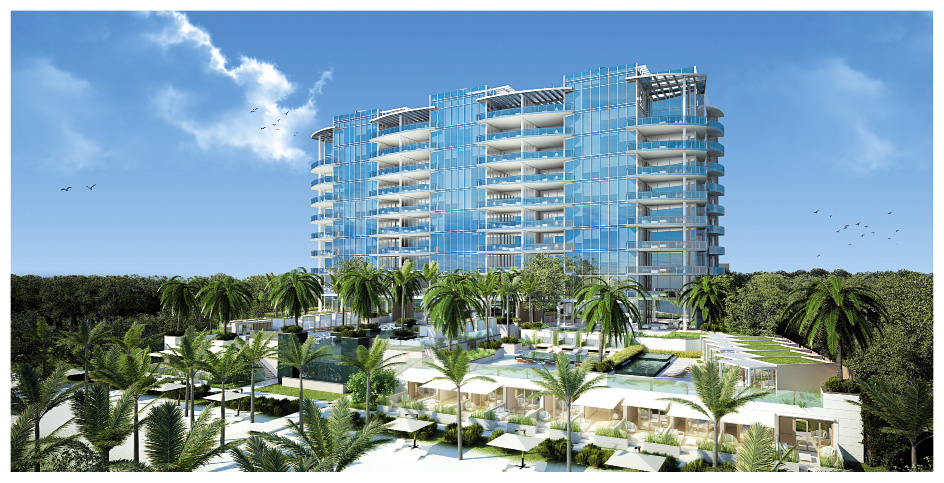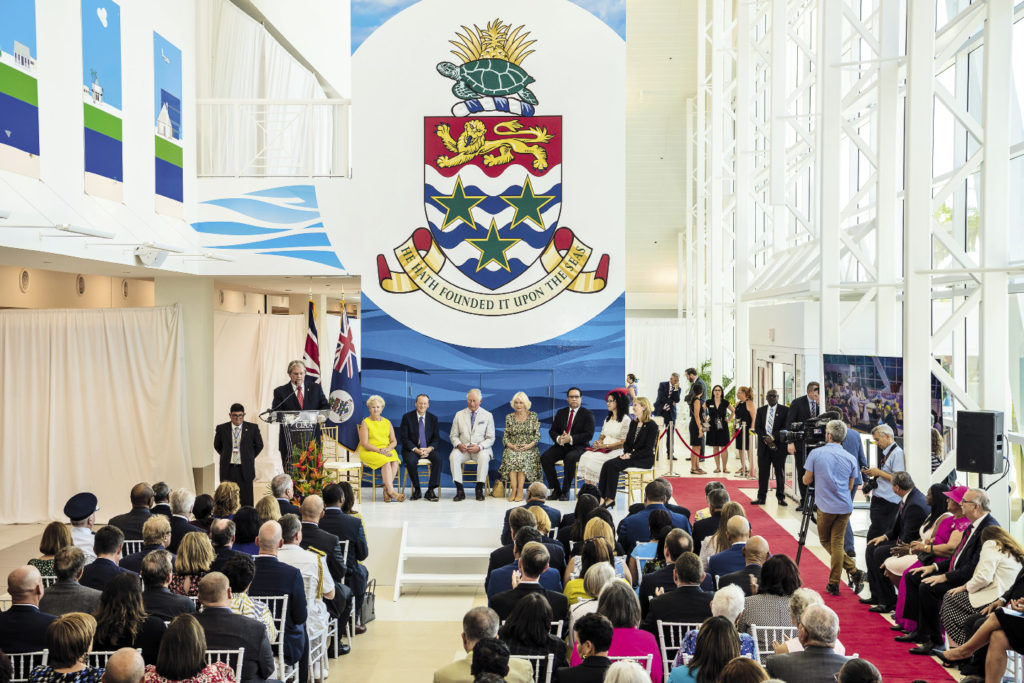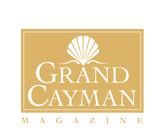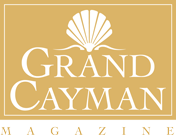Everyone should experience love at least once in their lifetime.
Love can take on many forms, such as love for a partner, newborn baby, family pet . . . and even love for a nation. As the British poet Lord Byron once said, “He who loves not his country, can love nothing.”
Currently, the Cayman Islands is at a unique period in its history — you could even say it’s experiencing a “renaissance.”
For decades, Grand Cayman has been known as a top tourist destination and leading global offshore financial center, but now new sectors of the economy are helping to define and grow the island on a world-class scale, in areas such as education, technology, and healthcare (including wellness and medical tourism).
Many residential and commercial projects are currently under way or near completion. From the recent $55 million expansion of Owen Roberts International Airport to the construction of a $17 million apartment and retail development at Health City Cayman Islands, prosperity is everywhere you turn.
Health City began 2019 by introducing a trauma-and-triage center and expanded medical intensive care unit, the culmination of a nine-month project that is aligned with both U.S. and U.K. guidelines and standards.
The hospital already delivers some of the most advanced healthcare services available. It is the first hospital in the English-speaking Caribbean, for example, to use robotic navigation for joint replacements and the first to implant artificial hearts, and more cutting-edge treatments are on the way.
Grand Cayman has long been synonymous with “luxury,” and the island continues to offer stay-over visitors experiences that are highly tailored and inspirational in unprecedented ways.
The award-winning Kimpton Seafire Resort + Spa helped usher in this new era of luxury tourism in 2016. It was Dart Real Estate’s first hotel and Grand Cayman’s first new hotel development in more than a decade, preceded by The Ritz-Carlton, Grand Cayman (which is also part of the Dart portfolio now, although originally spearheaded by developer Mike Ryan).
Now a new generation of resort-hotels and residences are being developed, such as The Watermark, The Grand Hyatt Grand Cayman Residences, Curio Collection by Hilton, and FIN, to name a few.
Cayman is offering many new educational opportunities for Caymanians and residents, and the course has been set to create new career paths and industries altogether.
Cayman International School’s $60 million expansion will double its current size and capacity in 2020 to include an early childhood campus and an 87,000- square-foot high school; meanwhile, Cayman Enterprise City (CEC) has broken ground on a new urban campus dedicated to digital businesses involved in emerging technologies like fintech, biotech, envirotech, and blockchain. Grand Cayman is fast becoming a Caribbean “tech hub,” thanks to CEC’s special economic zone, Cayman Tech City, which is home to 170 digital businesses and counting.
Culturally and socially, food occupies a place of importance, and Cayman has been dubbed the “Culinary Capital of the Caribbean” for good reason.
There is a fabulous array of high-quality restaurants and eateries, and a thriving farm-to-table and vegan scene, while the annual Cayman Cookout, hosted by The Ritz-Carlton, Grand Cayman, attracts the world’s most talented chefs, culinary influencers, and wine and spirits experts each January.
With the brand-new 60,000-square-foot Foster’s supermarket now open for business in Camana Bay, an even wider variety of gourmet, specialty, and organic products are available to tempt even the most discerning palates. From hot and cold delis to expansive cheese, meat, seafood and produce departments, Foster’s at Camana Bay is well stocked. The flagship store also features a floral department, pharmacy, health and beauty department, coffee and juice bar, and indoor and outdoor seating, making it a one-stop shop.
Underpinning it all is a tight-knit community, where even strangers stop to say “Hello” and offer a helping hand. (We call this “Caymankind.”)

Tourism and Growth
Tourism in Cayman is at an all-time high and is showing no signs of slowing.
An astounding 2.4 million visitors arrived by air and sea in 2018, which is the highest number recorded for a single year, and air arrivals continue to set records in 2019. In the first eight months of 2019, there was an 11 percent increase in air arrivals from the same period the year before.
Coldwell Banker’s 2019 Mid-Year Market Report states that cruise ship passengers and stay-over visitors spent a total of $880 million in the first half of the year. And now, the newly expanded airport can accommodate some 2.5 million passengers annually.
As of December 2018, there were 65,813 residents living in Cayman (a 3.3 percent increase from 2017), and Cayman’s per capita income rose from $68,000 to $71,000 — one of the highest per capita incomes in the world.
Cayman’s economic and population growth is also reflected in the local unemployment rate, which declined to 2.8 percent in 2018, with a 9.9 percent increase in the labor force.
The current government has made it a priority to stimulate growth in the capital, and many proposed projects are under review. The George Town revitalization project includes long-term plans to beautify downtown with changes to traffic and pedestrian flows, preservation of historic landmarks, new tree plantings, and improved lighting.
While the subject of a cruise berthing facility in the George Town Harbour remains controversial due to concerns that the project’s environmental impacts might outweigh its economic benefits, proponents believe that a proper docking facility will stimulate growth on the waterfront while maximizing the time cruise tourists spend on land in Grand Cayman.
The fate of the $200 million project is now in the hands of Caymanian voters. A referendum is scheduled to be held in December 2019, allowing citizens to cast their ballots in favor of or against the cruise dock.

Real Estate Forecast
Real estate development in Grand Cayman has been booming for the last few years, and this trend is projected to continue for 2020 and beyond.
Surveying firm Charterland reports more than $800 million in total sales of properties in Cayman in 2018, up 18 percent from the previous year, making it the best 12 months on record for the local property market. The report also indicates there were 1,857 property transfers in 2018, a 9 percent increase from the year before.
Kim Lund, broker/owner at RE/MAX Cayman, says that Cayman is experiencing a resurgence as the tourism sector sets records every month and more new residents arrive on our shores.
“Over the next five years, after a short pause to catch our breath, it appears that this trend will continue to drive new construction supported by consistently strong real estate sales activity in both resort and residential markets. Although the sales pace may be less than over the previous five years, it will still be at a strong and steady pace overall,” says Lund.
With record-breaking tourism numbers and a strong economy fueling the real estate boom, properties on Seven Mile Beach are seeing the most significant surge in value.
Lund says the lowest property sale prices on Seven Mile Beach range from $800 to $2,000 per square foot. “This is forecasted to increase, to likely, $300 to $500 more per square foot, as Cayman is still behind sales prices in other similar competitive resort markets,” he says.
Aside from the high levels of interest in new projects on Seven Mile Beach, Lund notes that residential development is heading farther east, in areas from South Sound to Bodden Town.

A Closer Look —
Luxury Resorts and Residential Developments
Seven Mile Beach, with its crystal-blue waters and powder-white sand, continues to be Cayman’s main draw for tourists and residents — and the hottest location for real estate activity.
The Watermark is a $177 million luxury condominium project from the developers of Stone Island and The WaterColours, located close to Public Beach between the Avalon and Harbour Heights residential complexes.
The 10-story, 54-unit development features 12 swimming pools, including four rooftop pools, and will be linked by a new pedestrian bridge over West Bay Road to a three-story building with a restaurant, spa, fitness center, and other facilities.
The Grand Hyatt Grand Cayman Residences is a $285 million development on the south tip of Seven Mile Beach that is expected to open in late 2020. Spearheaded by Pageant Beach Hotel Ltd., a consortium of highly experienced developers and investors, the luxury resort will include 250 hotel rooms and 100 two- and three-bedroom residences.
Amenities include a 12,000-square-foot wellness spa, three pools, retail shops, kids club, six distinct food and beverage venues, and 25,000 square feet of conference and meeting areas, making it one of the largest facilities for functions in Cayman.
Set for completion in summer 2021, the Curio Collection by Hilton will be the island’s first luxury wellness and business boutique hotel. Located on the edge of George Town, just south of Seven Mile Beach, the resort is being developed by NCB Group, known for its upscale residential projects such as Tides and Solara.
The resort will feature 80 one- to three-bedroom units available for purchase, including a number of condominiums for full-time residency. Resort amenities include a spa spanning the entire seventh floor, two farm-to-table restaurants, swim-up bar, state-of-the-art gym, yoga studio, and conference facilities.
Cayman’s biggest commercial real estate developer, Dart Real Estate, has partnered with NCB Group to create OLEA. Located close to Camana Bay’s Town Centre and Cayman International School, the residences are expected to range from one-bedroom condominiums to four-bedroom townhomes and will include sustainable features and amenities such as a resort-style pool, “lazy river,” fully equipped gym, and a community garden.
Dart has put forth a proposal to build an iconic 50-story five-star skyscraper resort on the Seven Mile Beach waterfront within the expanding Camana Bay development.
It is envisioned to be the tallest building in the Caribbean that could draw more visitors to the island — including billionaire investors — whilst symbolizing Cayman’s strength on the world stage.
Other “new” hotels include Locale, a boutique business hotel situated on West Bay Road that contains 42 rooms and a street-level restaurant, Bonfire; and Palm Heights, formerly Beach Suites, which has been reopened with a chic look and includes The Coconut Club beach bar.
The $50 million redesign of the Westin Grand Cayman Seven Mile Beach Resort & Spa has also been garnering much attention since it was completed in 2018. Each of the luxury hotel’s 343 rooms and suites was updated with a fresh, modern look, while the corridors, public spaces, pool deck, and retail gallery were also given extensive makeovers.
Natural materials can be seen throughout the resort and reflect the surrounding Caribbean landscape. The open and airy lobby area has a bright, neutral color palette that includes sand-tone wood plank flooring, organic columns, and planes of soft curves on the ceiling above. The lobby area also features floor-to-ceiling glass windows that offer stunning views of the ocean, while the freshwater swimming pool has been redesigned with a swim-up bar.
Along the Seven Mile Beach Corridor into West Bay, a number of high-end luxury residences are in development. They include The Residences of Stone Island, Diamond’s Edge and Nautica (both by Heritage Holdings Ltd.), and Dolphin Point Club (by Joseph Imparato).
Located at the tip of North West Point in West Bay, Dolphin Point Club will comprise 42 open-plan, one- to four-bedroom condominiums, all with panoramic views, and amenities including a rooftop restaurant.
The Grove is a $25 million project currently under construction on West Bay Road that will feature 58 apartments and a mix of retail outlets and restaurants on the ground floor, as well as a landscaped park and courtyard.
Other luxury residences are also taking shape across the island, including many in South Sound and the Red Bay area.
FIN is a modern art deco residential project in the up-and-coming South Church Street neighborhood, just south of downtown George Town. The ultra-luxury complex is set for completion in spring 2020, and is a joint partnership between the developer-duo Dale Crighton and Mike Ryan.
FIN features 36 oceanfront residences, with two to five bedrooms, set over four levels and includes a mix of single and multi-level condos, as well as two annex buildings with nine condo units for owners’ guests or renters. FIN’s amenities include 24-hour concierge, a 75-foot-long glass-bottomed cantilevered pool, CellArt wine room with individual wine storage lockers, yoga-gym-spa treatment room with access to a dedicated wellness expert, and two boats and three vehicles for the exclusive use of owners.
Davenport Development is now constructing Phase III of its iconic project VELA, which includes 56 units and the hallmark Olympic-training pool from its earlier phases. Davenport is also selling the final units of Arvia, a luxury canalfront development tucked away behind Hurley’s at Grand Harbour. The upscale gated community will comprise 96 condos set over 12 three-story buildings and offer an array of resort-style amenities, including the option to rent or own dock space in the marina-like setting.
Davenport’s newest project is Bahia, a gated community coming soon to the shores of South Sound. It will feature one- to four-bedroom oceanview townhomes with open rooftop terraces, two pools, an indoor and outdoor gym, a yoga studio, and a dedicated children’s playground.
A pair of new developments will soon breathe new life into the Red Bay area. NCB’s residential complex, AURA, will be situated just off the Grand Harbour roundabout. Designed by award-winning architect Robert Towell, AURA will comprise 39 two- to three-bedroom condominiums set over one and two stories, boasting ocean views from every residence.
Harbour Walk is a mixed-use real estate project set for completion in July 2021. Located between Periwinkle and The Shoppes at Grand Harbour, the development will include an array of shops, offices, restaurants, a bakery and cafe, and a rooftop bar. On the upper floors, Harbour Walk Residences offers 62 European-style apartments (one-bedroom, one-bed-plus-den, and two-bedroom). Owners will have full use of the amenities below.
Moving to the scenic Eastern districts, Joseph Imparato, developer of Caribbean Club and more recently Dolphin Point Club, is developing Rum Point Club Residences, which will be the only luxury boutique hotel in charming North Side.
The beachfront residences will comprise of 36 one,- two-, three- and four-bedroom condominiums, as well as feature a fully-equipped fitness center, spa, infinity pool, underground parking and dock rental for private boat or wave runner use. Additionally, owners and guests will have exclusive use of a water taxi concierge for door-to-door pick-ups from the airport, restaurants, and tourist attractions.
In south George Town, Cayman Enterprise City has already broken ground on the first phase of a 53-acre mixed-use development — expected to be a 25-year, $500 million project — that will create approximately one million square feet of world-class office space, residential areas, restaurants, and amenities.

Expansions and Upgrades
Infrastructure is the cornerstone of any society, and in anticipation of the country’s future growth, a number of road projects are in various stages of planning and construction, beginning with the expansion of the Linford Pierson Highway and extension of Elgin Avenue.
The Water Authority – Cayman is also planning to spend $148.6 million on 24 projects in the country over the next decade, with most of the projects aimed at maintaining and upgrading the existing water and wastewater infrastructure.
The airport’s new 200,000-square-foot facility includes a new departures and arrivals hall, and a new baggage and screening area. More unveilings are set in the coming year, including a children’s play area, mother’s nursing station, and digital flight information displays.
More flights to and from Grand Cayman have been added, connecting the island with more than two dozen airports in more than 20 metro areas. Newer carriers include Southwest Airlines, JetBlue, and Caribbean Airlines, while the country’s national airline Cayman Airways is pursuing a long-term plan to target West Coast cities, such as Los Angeles, San Francisco, Seattle, and Vancouver.
The Cayman Islands Airports Authority recently signed a $30 million contract with Canada-based IDL Projects Joint Venture for airfield upgrades, which include extending the airport ramp and taxiway. The partnership also includes local businesses Island Paving and Dart’s engineering arm DECCO.
Cayman has embarked upon an ambitious course of expansion and growth, building upon the country’s history while keeping a clear eye (and steady hand) on its future. No doubt, the next generations who inhabit these special islands will reap the many rewards of the plans currently in motion — and may perhaps reminisce about the “good old days” with a sense of pride, and more importantly, an abiding love of nation.


















